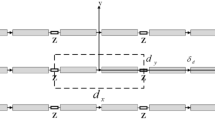Abstract
This paper presents an analytical model to design a self-complementary connected antenna array above artificial materials like high impedance surfaces (HIS). The objective of this model is to perform parametric studies to facilitate deeper understanding of a complex antenna array with a significantly shorter computation time than with electromagnetic simulators. The model of the complete structure has been designed in receiving mode when structure is illuminated with a plane wave and using transmission line model and ABCD matrix. By applying an interesting property which gives equivalence between the input impedance in transmit mode and the surface impedance in receiving mode, the impedance match of the self-complementary connected antenna array can be quickly calculated. It is also simple to evaluate the influence of the incidence angle on the reflection coefficient of a self-complementary connected antenna array above perfect electric conductor (PEC) or HIS. PEC or artificial materials can modify the antenna array behavior by either increasing the bandwidth or by adding additional bandwidths. All these results have been verified to be accurate by numerical simulations done with Ansys HFSS.








Similar content being viewed by others
References
Y. Mushiake, Self-complementary antennas. IEEE Antennas Propag. Mag. 34(6), 23–29 (1992)
M. Gustafsson, Use of dielectric sheets to increase the bandwidth of a planar self-complementary antenna array, in IEEE Antennas and Propagation Society International Symposium 2006, pp. 2413–2416 (2006)
D.M. Pozar, Microwave Engineering, 2nd edn. (Wiley, New York, 1998) pp. 206–213
O. Luukkonen, C. Simovski, G. Granet, G. Goussetis, D. Lioubtchenko, A.V. Räisänen, S.A. Tretyakov, Simple and accurate analytical model of planar grids and high-impedance surfaces comprising metal strips or patches. IEEE Trans. Antennas Propag. 56(6), 1624–1632 (2008)
D. Cavallo, A. Neto, G. Gerini, Green’s function based equivalent circuits for connected arrays in transmission and in reception. IEEE Trans. Antennas and Propag. 59(5), 1535–1545 (2011)
F. Linot, Apport des Surfaces à Haute Impédance à la conception d’antennes réseaux compactes et d’antennes réseaux à très large bande passante, PhD Thesis Telecom ParisTech, April 7th 2011
F. Linot, X. Begaud, M. Soiron, C. Renard, M. Labeyrie, Characterization of a loaded high impedance surface, Int. J. Microw. Wireless Technol. 1(06), 483–487 (2009)
Acknowledgments
The present work has been led in the framework of the ITP SIMCLAIRS competed program. France, United Kingdom and Sweden have mandated the European Defence Agency (EDA) to contract the Project with a Consortium composed of THALES SYSTEMES AEROPORTES France, acting as the Consortium Leader, SELEX Galileo Ltd, THALES UK Ltd. and SAAB AB.
Author information
Authors and Affiliations
Corresponding author
Rights and permissions
About this article
Cite this article
Begaud, X., Linot, F., Soiron, M. et al. Analytical model of a self-complementary connected antenna array on high impedance surface. Appl. Phys. A 115, 517–522 (2014). https://doi.org/10.1007/s00339-013-8077-5
Received:
Accepted:
Published:
Issue Date:
DOI: https://doi.org/10.1007/s00339-013-8077-5




